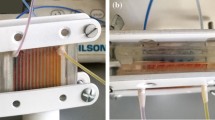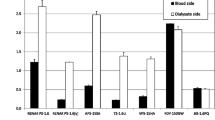Abstract
The objective of this study was to evaluate the effect of protracted storage of dialyzers on the amount of poly(N-vinyl-2-pyrrolidone) (PVP) eluted from polysulfone-group dialysis membranes. We tested five dialysis membranes: APS-15SA (Asahi Kasei Kuraray, wet), CX-1.6U (Toray, moist), FX140 (Fresenius, dry), PES-15Sα (Nipro, dry), and FDX-150GW (Nikkiso, wet). Each dialyzer was stored for 1, 3, 14, and 18 months after sterilization. The dialysis-fluid side compartment was primed with reverse osmosis (RO) water at 500 mL/min for 5 min at 310 K. The blood side compartment was primed with RO water at 200 mL/min for 5 min at 310 K. Finally, 1 L RO water was circulated through the blood side compartment at 200 mL/min for 4 h at 310 K. Eluted PVP was determined by use of the iodine method, using 0.02 N iodine solution. PVP was mainly eluted from wet-type dialyzers during priming. Thus, the standard 5 min priming of the wet-type dialyzer according to the maker manual inhibits PVP elution during circulation. PVP was eluted in the dialysis-fluid side of the moist-type dialyzer during priming but no PVP was eluted in the blood side. PVP was mainly eluted from dry-type dialyzers during circulation. We recommend more than the standard 5 min priming, particularly for dry-type dialyzers stored for protracted periods, because 5 min insufficient to inhibit PVP elution during circulation.



Similar content being viewed by others
References
Frank HP. The lactam-amino acid equilibria for ethylpyrrolidone and polyvinylpyrrolidone. Polym J Sci. 1954;12:565–76.
Doneux C, Caudano R. Polymerization of N-vinyl-2-pyrrolidone under anodic polarization: characterization of the modified electrode and study of the grafting mechanism. Langmuir. 1997;13:4898–905.
Pert JH, Moore R, Schork PK. Review of studies in blood freezing using glucose-lactose and polyvinylpyrrolidone methods. National research council: conference on long-term preservation of red blood cells; 1965.
Koshikawa S. Transfusion. Tokyo: Chugai Iyakusha; 1960, p. 173–87 (in Japanese).
Arakawa M, Suzuki S. Withdrawal of PVP drug. Nihon Iji Shinpo 1965;3375:126 (in Japanese).
Streicher E, Schneider H. Polysulfone membrane mimicking human glomerular basement membrane. Lancet. 1983;2:1136.
Ochoa NA, Pradanos P, Palacio L, Pagliero C, Marchese J, Hernández A. Pore size distributions based on AFM imaging and retention of multidisperse polymer solutes: characterisation of polyethersulfone UF membranes with dopes containing different PVP. J Membr Sci. 2001;187:227–37.
Matsuda M, Yamamoto K, Yakushiji T, Fukuda M, Miyasaka T, Sakai K. Nanotechnological evaluation of protein adsorption on dialysis membrane surface hydrophilized with polyvinylpyrrolidone. J Membr Sci. 2008;310:219–28.
Namekawa K, Fukuda M, Matsuda M, Yagi Y, Yamamoto K, Sakai K. Nanotechnological characterization of human serum albumin adsorption on wet synthetic polymer dialysis membrane surfaces. ASAIO J. 2009;55:236–42.
Hayama M, Yamamoto K, Kohori F, Uesaka T, Ueno Y, Sugaya H, Itagaki I, Sakai K. Nanoscopic behavior of polyvinylpyrrolidone particles on polysulfone/polyvinylpyrrolidone film. Biomaterials. 2004;25:1019–28.
Hayama M, Yamamoto K, Kohori F, Sakai K. How polysulfone dialysis membranes containing polyvinylpyrrolidone achieve excellent biocompatibility? J Membr Sci. 2004;234:41–9.
Matsuda M, Sato M, Sakata H, Ogawa T, Yamamoto K, Yakushiji T, Fukuda M, Miyasaka T, Sakai K. Effects of fluid flow on elution of hydrophilic modifier from dialysis membrane surfaces. J Artif Organs. 2008;11:148–55.
Müller K. Detection and determination of polyvinylpyrrolidone (PVP) and determination of active components in PVP-containing drug preparations. Pharm Acta Helv. 1968;43:107–22 (in German).
Trimpin S, Eichhorn P, Räder HJ, Müllen K, Knepper TP. Recalcitrance of poly(vinylpyrrolidone): evidence through matrixassisted laser desorption–ionization time-of-flight mass spectrometry. J Chromatogr A. 2001;938:67–77.
Benamer S, Mahlous M, Boukrif A, Mansouri B, Larbi Youssef S. Synthesis and characterisation of hydrogels based on poly(vinyl pyrrolidone). Nucl Instrum Methods Phys B. 2006;248:284–90.
Davis EJ, Senogles E. γ-Irradiation of N-vinylpyrrolidin-2-one and its homopolymer. Aust J Chem. 1981;34:1413–21.
Peniche C, Zaldivar D, Pazos M, Paz S, Bulay A, San Roman J. Study of the thermal degradation of poly(N-vinyl-2-pyrrolidone) by thermogravimetry-FTIR. J Appl Polym Sci. 1993;50:485–93.
Hassouna F, Therias S, Mailhot G, Gardette JL. Photooxidation of poly(N-vinylpyrrolidone) (PVP) in the solid state and in aqueous solution. Polym Degrad Stab. 2009;94:2257–66.
Acknowledgments
This work was carried out in the Global COE program “Center for Practical Chemical Wisdom” and the Encouraging Development Strategic Research Centers Program (Super COE) “Establishment of a Consolidated Research Institute for Advanced Science and Medical Care” from the Ministry of Education, Culture, Sports, Science and Technology, Japan (MEXT).
Author information
Authors and Affiliations
Corresponding authors
Rights and permissions
About this article
Cite this article
Namekawa, K., Kaneko, A., Sakai, K. et al. Longer storage of dialyzers increases elution of poly(N-vinyl-2-pyrrolidone) from polysulfone-group dialysis membranes. J Artif Organs 14, 52–57 (2011). https://doi.org/10.1007/s10047-011-0552-1
Received:
Accepted:
Published:
Issue Date:
DOI: https://doi.org/10.1007/s10047-011-0552-1




